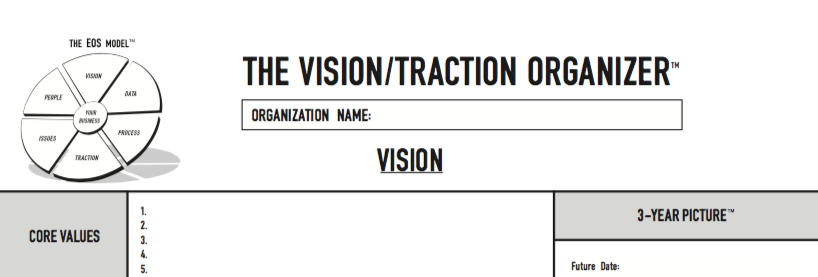The Vision/Traction Organiser (VTO) is probably the most important document you’ll complete, if you’re running your business on the Entrepreneurial Operating System.
It is a unique two-page template for organising plans and forecasts the future of a company. Once completed it acts as a time-management tool, helping you decide when to action each element of your strategy.
We have all seen simple one-page solutions for creating and organising your company strategy, but the VTO is different.
Usually, businesses devote a lot of time and resources to assigning committees to work on a different sections of their business strategy. This frequently leads to the production of long 50-100 page documents which sometimes these aren’t joined up with the big picture or simple to communicate.
The VTO is unique because it organises both the ‘vision’ component of your business and includes your plan to make that vision a reality.
The simple approach involves answering eight fundamental questions to get the entire leadership team thinking and working on the same page.
What is in your VTO – the Vision page
The vision page consists of five divided sections which helps to crystallise the components of your vision.
- Core Values
This is all about who the company is and its culture. This is essential in order to define who fits in the organisation and who doesn’t. It is important to hire, fire, review and reward based on your core values.
- Core Focus
This is frequently referred to as ‘mission’, ‘vision’, or ‘voice’. It is all about defining why the company exists and identifying your superior skill. Once defined the combination of these two things helps you to stay focused. It is easy to get distracted by non-core activities.
Businesses can select the time-horizon – five-25 years – however typically, clients want a horizon of 10 years. This is equatable to your BEHAG (Big Hairy Audacious Goal) and once defined helps everyone to see the big picture of the organisation – where it’s going.
- Marketing Strategy
This sets out how you sell your product or service, and involves four simple steps: identifying the target market – your ideal list of customers; defining the most attractive message for that target market (discovering your three uniques); understanding the process a client goes through to work with your company; and deciding whether there is a guarantee you can offer that client.
- Three Year Picture
Here you paint a picture of what the company will look like three years from now. This helps everywhere to see where the business will be and how they are part of it. It is divided into two parts: the specific targets of what you will achieve (future date, revenue, profit and measurables), plus “what does it look like” where we paint a picture with the number of employees, clients, new products, market and sales efforts, awards you will win and so on.
Once you have a detailed, compelling Three Year Picture, you move onto the second page of your VTO – Traction.
What is in your VTO – the Traction page
The Traction page consists of three divided sections which help you execute the vision you have created.
- One year plan
Once you have a compelling three year picture, you take one third of that picture to create your one year plan. As with the three year picture, you have the specific targets of what you will achieve in the next 12 months and you establish between one and seven SMART goals that will enable you to meet those specific targets.
Here you set three to seven priorities for the business for the next 90 days. Most companies try to focus on too many objectives. Having no more than seven means you are more likely to achieve them.
The final component of the Traction page is a list of all the issues the business is facing. This includes both obstacles, challenges, problems, opportunities and ideas which need to be discussed and agreed by the team.
If you’re working with a professional Implementer, they will help to facilitate discovery exercises so that you can define and agree these eight sections. This becomes an essential working document, continually referred to and updated every 90 days as your business progresses and grows.

